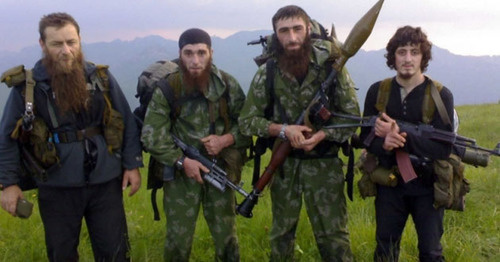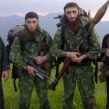
Growing Islamic State Influence in North Caucasus Casts Shadow on Local Salafists
Publication: Eurasia Daily Monitor Volume: 13 Issue: 5
By:

In 2015, Russia changed its assessment of threats, shifting its focus from the Caucasus Emirate to members of the so-called Islamic State (IS). The Russian government’s concern is not so much about the numbers of people who went to Syria and may return, but rather the possible influence the ideas of the IS might have among Russia’s 20 million Muslims.
The activities of the IS in the North Caucasus also should be evaluated in the context of the armed Islamic underground movement and those Salafists who sympathize with it. According to Dagestan’s governor, Ramazan Abdulatipov, only 643 residents of the republic are fighting in the ranks of the IS. Dagestani Interior Minister Abdurashid Magomedov estimated the number of Dagestani IS recruits at 900 as of December 2015 (Kavkazsky Uzel, December 10, 2015).
Abdulatipov must have meant only those individuals who went to Syria and whose involvement in insurgent activities has been confirmed. The Russian Ministry of Interior claims that jointly with the Federal Security Service (FSB), it is monitoring over 2,800 Russian citizens who went to fight in Syria and Iraq. In addition, the interior ministry launched criminal investigations into 889 militants who returned from the Middle East. This information from the Russian interior ministry was in response to a query by State Duma deputy Valery Rashkin about the steps that the government is taking to counter the terrorist threat. The Ministry of Interior also said that it had identified 92 recruiters for foreign-based illegal armed groups (Rbc.ru, December 25, 2015).
For the first time, the FSB revealed that it has definitive information on over 2,800 Russians who have joined the insurgency in Syria. Thus, over the past several years, Russian authorities have discovered the identities of about half the Russian militants fighting in Syria. This was made possible by moles in the Russian security services planted among the radicals. According to the deputy State Duma speaker Aleksandr Khinshtein, Russia’s Investigative Committee filed about 600 cases against Islamist recruiters (Rbc.ru, December 25, 2015). This very large number never has previously appeared before in open sources.
Abdulatipov’s proposal to strip passports from those who plan to go fight on the side of the terrorists is unlikely to help (Rbc.ru, December 25, 2015). Chechnya’s ruler, Ramzan Kadyrov, proposed the same thing several months earlier. Kadyrov said the authorities should prevent those who went to Syria from returning to Russia, saying: “We cannot provide ten police officers to guard every person who returns from the Middle East.” At the same time, Kadyrov noted that “Chechnya accumulated priceless experience of fighting terrorism that is of interest to various countries.” However, Kadyrov did not specify which countries were studying his experience (Golosislama.com, July 24, 2015). Abdulatipov only repeated what Kadyrov had said earlier because the Kremlin apparently backed Kadyrov’s initiative, otherwise Abdulatipov would have feared replicating it. The governor of Ingushetia, Yunus-Bek Yevkurov, has also endorsed legislative proposals to strip those who went to Syria of Russian citizenship (Rg.ru, September 8, 2015).
Salafists in the North Caucasus have also become targets of the Russian government, which sees them as a force somewhat affiliated with the IS. The North Caucasian Salafists may have nothing to do with the IS, but the government tends to regard them as likely IS allies and adversaries of Russia. The widespread opinion in Russia that all Salafists support the IS is patently false. The police regularly fingerprints Salafists, detains them after Friday prayers, fabricates criminal cases against them, forbids certain types of hijab and beard, etc. The harassment of local Salafist communities has further radicalized young people and replenished the ranks of the armed Islamic underground movement.
According to the director of the International Crisis Group’s North Caucasus project, Yekaterina Sokiryanskaya, “Salafis in the North Caucasus have become synonymous with terrorists; regardless of their actual participation in any criminal activities, they still come under pressure. This situation can be seen in Dagestan and Chechnya,” she said, adding that simply visiting a Salafist mosque or wearing a beard is enough to turn someone into a suspect and an outlaw. The director of Human Rights Watch in Russia, Tatyana Lokshina, the Russia program director and a senior researcher at the organization, noted that the Salafists in Russia are not a political force or movement. They are deeply divided and sometimes have divergent opinions about the situation in Russia and abroad. Russia creates problems for itself by radicalizing those who would prefer to remain in their personal space of understanding Islam and avoid joining political battles (Kavkazsky Uzel, January 1, 2016).
Thus, despite the claims that the armed Islamist underground movement in the North Caucasus is winding down, the Russian authorities recognize that there were one-and-a-half times more terrorist crimes in Russia in 2015 than in the previous year (Rbc.ru, December 28, 2015). This increase took place against the backdrop of the increasing influence of the Islamic State in Russia. Given the fact that the IS first started exerting influence in Russia in the summer of 2015, Russia will start experiencing serious challenges in 2016. If the international coalition does not turn the tide against the IS in Syria and Iraq, a difficult year lies ahead for Russia.




